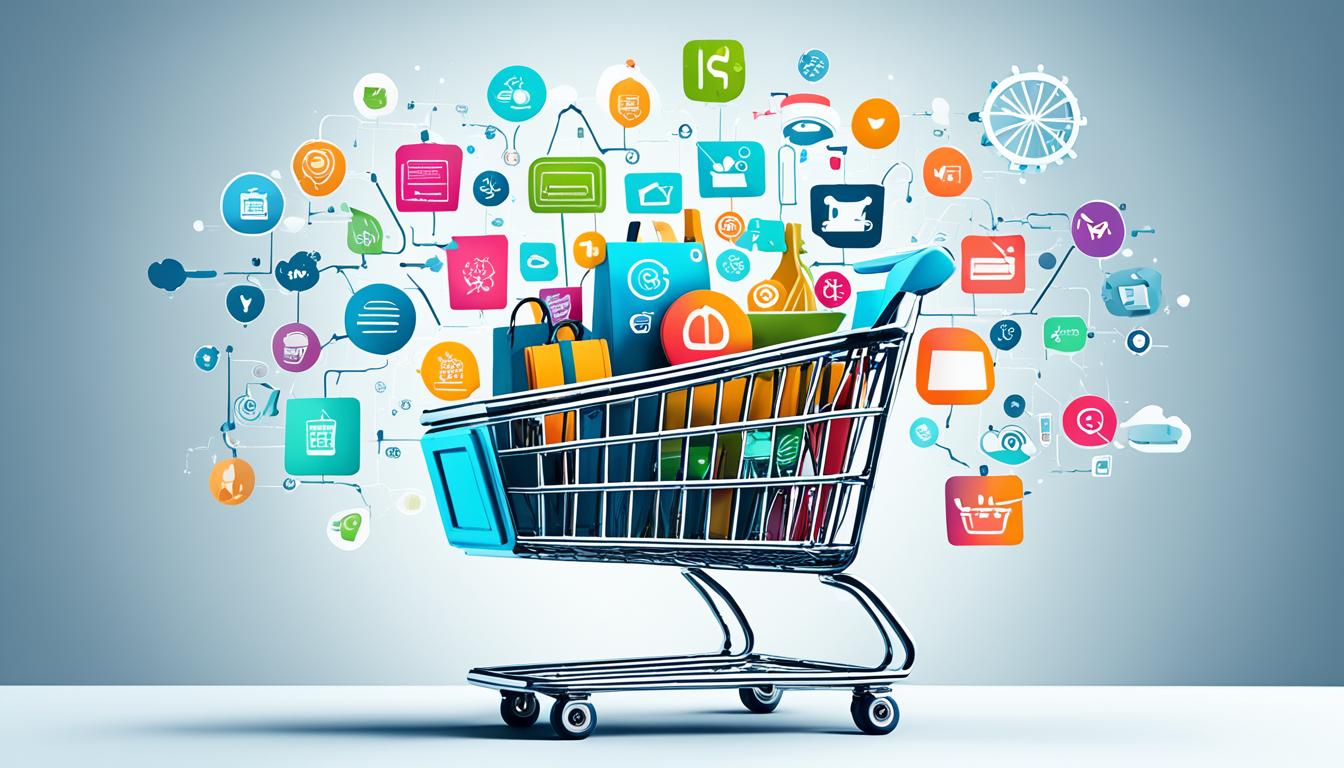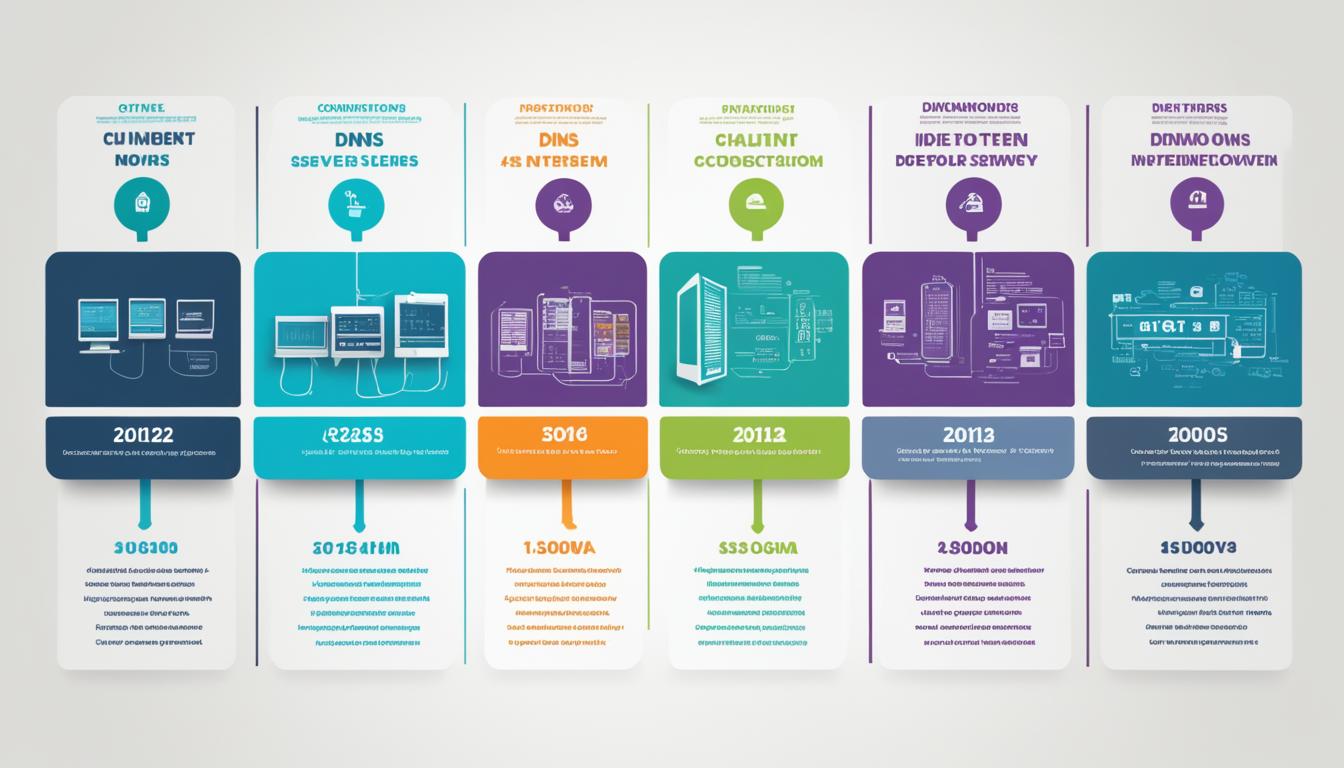Development & History of E-commerce: Past, Present & Future
Did you know that e-commerce sales reached a staggering $115 billion in just the third quarter of 2017, reflecting a 15.5% increase from the previous year? This surprising statistic highlights the incredible growth and impact of online retail in today’s digital age.
Over the last couple of decades, e-commerce platforms like Amazon and Alibaba have become household names, offering great deals and convenient purchasing options. The history of e-commerce is eventful, with significant milestones shaping its development and growth. The industry has seen exponential growth, revolutionizing the way businesses operate and transforming the shopping experience for customers.
Key Takeaways:
- E-commerce sales reached $115 billion in Q3 2017, marking a 15.5% increase from the previous year.
- E-commerce has revolutionized the way businesses operate and transformed the shopping experience for customers.
- E-commerce platforms like Amazon and Alibaba have become household names, offering great deals and convenience.
- The history of e-commerce is filled with significant milestones that have shaped its development and growth.
- Exponential growth in the industry has opened up opportunities for businesses to reach international audiences and track customer preferences through analytical data.
Why E-commerce?
In today’s digital era, e-commerce has become the go-to platform for businesses and consumers alike. With its numerous advantages, online shopping offers unparalleled convenience, enhanced business exposure, cost-effective marketing, and personalized messaging.
One of the key benefits of e-commerce is the ability for customers to easily browse through a wide range of products at their own pace. Whether they’re looking for the latest fashion trends, electronic gadgets, or home decor, online shopping provides a vast selection of options. Customers can compare prices and read reviews from other buyers, allowing for informed purchasing decisions.
The convenience factor is also a major draw for consumers. With e-commerce, customers can shop anytime, anywhere, from the comfort of their own homes. This eliminates the hassle of driving to physical stores, dealing with long checkout lines, and carrying heavy shopping bags. Online shopping gives customers the flexibility to make purchases whenever it’s most convenient for them.
For businesses, e-commerce offers unparalleled exposure. By having an online presence, companies can reach a global audience, transcending geographic boundaries. This opens up new market opportunities and allows businesses to expand their customer base. With the power of websites, social media, and blogs, e-commerce provides cost-effective marketing channels that can reach a wider audience than traditional advertising methods.
In addition, e-commerce allows businesses to leverage analytics to gain insights into customer preferences and behaviors. By analyzing data, businesses can deliver personalized messages and recommendations to customers, enhancing the overall shopping experience. Personalization creates a sense of connection and loyalty, fostering long-term customer relationships.
Overall, the benefits of e-commerce are undeniable. From its convenience and business exposure to cost-effective marketing and personalized messaging, online shopping has revolutionized the way we do business and has become an integral part of our lives.
Driving the Change
The progress of technology and e-commerce has been driven by the changing needs and behaviors of consumers. As technology advancements continue to reshape the digital landscape, businesses must adapt to meet the evolving demands of their customers.
One of the key factors influencing the development of e-commerce is big data. With the vast amount of data being generated by online platforms, businesses now have access to valuable insights about consumer behavior. By analyzing buyer behavioral patterns and preferences, businesses can better understand their customers and tailor their offerings accordingly. This data-driven approach allows for targeted marketing strategies and customer journey optimization.
Changing consumer behavior also plays a significant role in driving the change in e-commerce. With the rise of mobile devices and internet access, consumers have become more reliant on online platforms for their shopping needs. The convenience and accessibility of online shopping have transformed buyer habits, leading to a shift in purchasing behavior.
Customer journey optimization is another important aspect of driving the change in e-commerce. Businesses must focus on optimizing the entire customer journey, from initial discovery to post-purchase engagement. By leveraging technology and data, businesses can create a seamless and personalized shopping experience for their customers.
The integration of technology and data has fueled the growth of e-commerce and enabled businesses to provide a more personalized and targeted shopping experience. As technology continues to advance and consumer behavior evolves, it is essential for businesses to stay ahead of these changes and adapt their strategies accordingly.

Key Drivers of Change in E-commerce:
- Technology advancements
- Changing consumer behavior
- Big data and analytics
- Buyer behavioral patterns
- Customer journey optimization
History of E-commerce: 1960–1994
The history of e-commerce dates back to the 1960s when the concept of Electronic Data Interchange (EDI) was developed. EDI revolutionized the way businesses exchanged data by enabling digital transfer without the need for human intervention. This innovation replaced traditional mail and fax systems, paving the way for a more efficient and streamlined process.
In 1972, a significant milestone in e-commerce was achieved with the first recorded online transaction. According to reports, Stanford students sold cannabis to their counterparts at MIT using an Arpanet account. This event marked the beginning of online transactions and showcased the potential of e-commerce in facilitating remote trade.
Another key development in 1979 was the concept of online shopping. English inventor Michael Aldrich connected a television to a transaction processing computer through a telephone line, inventing what he called “teleshopping.” Although primarily used for non-retail purposes at the time, this concept set the stage for the future of consumer online shopping.
The early 1990s witnessed significant advancements in e-commerce. In 1990, Tim Berners-Lee created the WorldWideWeb, which became publicly available in 1991. This development opened up new possibilities for online communication and commerce, laying the foundation for the modern internet as we know it.
During this era, secure online purchases gained traction, ensuring consumer trust and confidence. Additionally, the first e-commerce site, Book Stacks Unlimited, was launched, offering a range of books to online customers. To enhance security further, SSL encryption was introduced, providing a safer browsing and shopping experience for users.

| Year | Milestone |
|---|---|
| 1960s | Development of Electronic Data Interchange (EDI) |
| 1972 | First recorded online transaction |
| 1979 | Concept of online shopping introduced |
| 1990 | Creation of the WorldWideWeb by Tim Berners-Lee |
| 1991 | Debut of the first e-commerce site (Book Stacks Unlimited) |
| 1994 | Introduction of SSL encryption for improved security |
Development of E-commerce: 1995–Present
In the mid-1990s, the e-commerce landscape experienced significant growth and innovation, driven by the emergence of influential players like Amazon and eBay. While initially starting as an online bookstore, Amazon quickly expanded its offerings and transformed into the largest online retailer worldwide. Today, it provides customers with a vast array of products, ranging from electronics to clothing and everything in between.
On the other hand, eBay introduced a revolutionary concept with its online auction platform. This pioneering approach allowed individuals to buy and sell products online, transforming the traditional retail dynamics. As a result, online auctions gained immense popularity, enabling customers to find unique and rare items while providing sellers with a convenient platform to reach a wider audience.
Furthermore, the introduction of PayPal in the late 1990s revolutionized online payment processing. As a secure and widely accepted payment solution, PayPal provided customers and online sellers with a seamless and trustworthy transaction experience, fostering trust and confidence in e-commerce.
In addition to these industry giants, other notable developments played a crucial role in shaping the e-commerce landscape. One of them was the introduction of Google AdWords. This advertising platform allowed businesses to optimize their online ads, effectively reaching their target audience and driving relevant traffic to their websites.
Moreover, numerous eCommerce platforms emerged, such as Etsy, Shopify, and BigCommerce. These platforms provided entrepreneurs with the tools and resources needed to establish and grow their online businesses, expanding the market and creating new opportunities for retailers of all sizes.
With the advent of mobile devices, mobile commerce gained momentum, enabling customers to make purchases on-the-go. The convenience and accessibility of mobile apps and responsive websites opened up a new avenue for businesses to connect with their customers.
Another significant development in recent years is the rise of the subscription-based business model. By offering recurring subscriptions, businesses can provide customized experiences to their customers while enjoying consistent revenue streams. This model has found success in various industries, including streaming services, beauty and grooming products, and meal kit deliveries.
| E-commerce Milestones | Year |
|---|---|
| Amazon launches as an online bookstore | 1995 |
| eBay introduces online auctions | 1995 |
| PayPal is launched | Late 1990s |
| Google AdWords is introduced | 2000 |
| Emergence of eCommerce platforms: Etsy, Shopify, and BigCommerce | Early 2000s |
| Rise of mobile commerce | Mid-2000s |
| Subscription-based business model gains popularity | Recent years |
Future of E-commerce: Predictions
The future of e-commerce is filled with promise and innovation, as businesses adapt to meet the evolving needs of consumers. Several key trends are set to shape the landscape of online shopping, driving further growth and transformation.
B2B eCommerce
B2B e-commerce is poised for substantial growth, with sales predicted to reach $1.5 trillion in 2021. Businesses are recognizing the immense potential of expanding their online presence to tap into the global market. B2B e-commerce enables companies to connect with international suppliers and customers, facilitating seamless transactions and paving the way for increased efficiency and scalability.
Green Consumerism
With a growing emphasis on sustainability, consumers are demanding environmentally-friendly products and supporting brands that align with eco-conscious values. The future of e-commerce will witness a surge in green consumerism, where businesses integrate sustainable practices into their supply chains and offer eco-friendly options. This shift towards environmentally-responsible shopping will drive the development of new technologies and practices in the e-commerce industry.
AI-based Shopping and Voice Search
Artificial intelligence (AI) will play a pivotal role in enhancing the user experience and revolutionizing the way people shop online. AI-based shopping algorithms will leverage data analytics and machine learning to provide personalized recommendations and streamline the purchasing process. Voice search capabilities will become more prevalent, allowing consumers to interact with e-commerce platforms using natural language, further simplifying and accelerating the buying journey.
Growth of Mobile Commerce and Mobile Wallets
The rise of smartphones has transformed the way people shop, leading to the exponential growth of mobile commerce. In the future, this trend will continue, as more businesses optimize their websites and apps for mobile devices. Additionally, the integration of mobile wallets will make online shopping even more convenient, with seamless and secure payment options directly from mobile devices.
Product Customization and Omnichannel Strategy
Personalization is becoming increasingly important to consumers, and e-commerce businesses are responding by offering product customization options. The future of e-commerce will see further advancements in this area, with more brands providing the ability to tailor products to individual preferences. Additionally, an omnichannel strategy will be crucial in creating seamless customer experiences across multiple touchpoints, integrating physical stores, websites, social media platforms, and mobile apps.
As e-commerce continues to evolve and adapt, these predictions provide a glimpse into the exciting future of online shopping. By embracing the opportunities presented by B2B e-commerce, green consumerism, AI-based shopping, voice search, mobile commerce, product customization, and an omnichannel strategy, businesses can position themselves for success in the ever-changing e-commerce landscape.
Opportunity for B2B eCommerce
B2B e-commerce presents businesses with a significant opportunity to expand their reach and tap into the global market. By embracing B2B e-commerce, companies can enjoy a host of benefits that enhance their efficiency, cost savings, scalability, and streamline their processes.
One of the key advantages of B2B e-commerce is the ability to efficiently connect with international suppliers and customers. This global reach not only enhances competitive advantage but also drives growth. By leveraging technology and digital platforms, businesses can foster stronger relationships with partners and customers across borders, paving the way for new opportunities and increased revenue.
By shifting to B2B e-commerce, companies can streamline their operations and enjoy improved efficiency. With automated processes, including order processing, inventory management, and payment systems, businesses can save valuable time and resources. This efficiency translates into cost savings, allowing organizations to allocate their budgets more strategically and invest in further growth.
Scalability is another key benefit of B2B e-commerce. As businesses expand, traditional models may struggle to keep up with increasing demands. However, with an e-commerce platform, scaling operations becomes more manageable. Through features such as automated inventory management, scalable payment gateways, and flexible product catalogs, businesses can easily adapt to changing market dynamics and accommodate growing customer needs.
In essence, the opportunity for B2B e-commerce lies in its ability to empower businesses with the tools and resources needed to succeed in the digital age. By embracing this innovative approach, companies can unlock their potential, tap into the global market, and thrive in a streamlined and efficient business environment.
FAQ
What is e-commerce?
How has e-commerce evolved over time?
What are the advantages of e-commerce?
How has technology driven the growth of e-commerce?
What are some key milestones in the history of e-commerce?
What are some popular e-commerce platforms?
What does the future of e-commerce look like?
FAQ
What is e-commerce?
E-commerce, or electronic commerce, refers to the buying and selling of goods and services over the internet. It involves online transactions, digital payments, and the exchange of goods and services without physical presence.
How has e-commerce evolved over time?
E-commerce has come a long way since its inception. It has seen significant advancements in technology, platforms, and consumer behavior. From the development of online shopping to the rise of mobile commerce and AI-based shopping, e-commerce has continuously evolved to meet changing demands.
What are the advantages of e-commerce?
E-commerce offers numerous benefits for both businesses and customers. Customers enjoy the convenience of browsing and purchasing products from the comfort of their homes. Businesses benefit from increased exposure, cost-effective marketing, and the ability to track customer preferences through analytics.
How has technology driven the growth of e-commerce?
Technology has played a vital role in the growth of e-commerce. The rise of big data has made it easier for businesses to understand consumer behavior and improve the customer experience. Additionally, advancements in mobile technology, secure online payments, and AI-based solutions have transformed the way businesses operate and interact with customers.
What are some key milestones in the history of e-commerce?
The history of e-commerce can be traced back to the development of the Electronic Data Interchange (EDI) in the 1960s, which allowed data exchange through digital transfer. The first online transaction occurred in 1972, and the concept of online shopping was introduced in 1979. Further milestones include the creation of the WorldWideWeb in 1990, the emergence of major players like Amazon and eBay in 1995, and the introduction of secure online purchases and SSL encryption.
What are some popular e-commerce platforms?
Some popular e-commerce platforms include Amazon, eBay, Etsy, Shopify, and BigCommerce. These platforms provide businesses with the tools and infrastructure to sell products online, reach a wide audience, and manage their online stores.
What does the future of e-commerce look like?
The future of e-commerce is predicted to be driven by B2B e-commerce, sustainability, and AI-based solutions. B2B e-commerce sales are expected to reach
FAQ
What is e-commerce?
E-commerce, or electronic commerce, refers to the buying and selling of goods and services over the internet. It involves online transactions, digital payments, and the exchange of goods and services without physical presence.
How has e-commerce evolved over time?
E-commerce has come a long way since its inception. It has seen significant advancements in technology, platforms, and consumer behavior. From the development of online shopping to the rise of mobile commerce and AI-based shopping, e-commerce has continuously evolved to meet changing demands.
What are the advantages of e-commerce?
E-commerce offers numerous benefits for both businesses and customers. Customers enjoy the convenience of browsing and purchasing products from the comfort of their homes. Businesses benefit from increased exposure, cost-effective marketing, and the ability to track customer preferences through analytics.
How has technology driven the growth of e-commerce?
Technology has played a vital role in the growth of e-commerce. The rise of big data has made it easier for businesses to understand consumer behavior and improve the customer experience. Additionally, advancements in mobile technology, secure online payments, and AI-based solutions have transformed the way businesses operate and interact with customers.
What are some key milestones in the history of e-commerce?
The history of e-commerce can be traced back to the development of the Electronic Data Interchange (EDI) in the 1960s, which allowed data exchange through digital transfer. The first online transaction occurred in 1972, and the concept of online shopping was introduced in 1979. Further milestones include the creation of the WorldWideWeb in 1990, the emergence of major players like Amazon and eBay in 1995, and the introduction of secure online purchases and SSL encryption.
What are some popular e-commerce platforms?
Some popular e-commerce platforms include Amazon, eBay, Etsy, Shopify, and BigCommerce. These platforms provide businesses with the tools and infrastructure to sell products online, reach a wide audience, and manage their online stores.
What does the future of e-commerce look like?
The future of e-commerce is predicted to be driven by B2B e-commerce, sustainability, and AI-based solutions. B2B e-commerce sales are expected to reach $1.5 trillion in 2021. Artificial intelligence is expected to enhance the user experience, with features like AI-based shopping and voice search becoming more prevalent.
What are the benefits of B2B e-commerce?
B2B e-commerce offers businesses increased efficiency, cost savings, scalability, and streamlined processes. It allows businesses to connect with international suppliers and customers, expand their reach, and unlock new opportunities for growth.
.5 trillion in 2021. Artificial intelligence is expected to enhance the user experience, with features like AI-based shopping and voice search becoming more prevalent.
What are the benefits of B2B e-commerce?
B2B e-commerce offers businesses increased efficiency, cost savings, scalability, and streamlined processes. It allows businesses to connect with international suppliers and customers, expand their reach, and unlock new opportunities for growth.
What are the benefits of B2B e-commerce?
- How Strategic SEO Drove Growth for a CPAP E-commerce Brand - July 24, 2025
- Top 3 SEO Companies in Toronto: An Analytical Comparison - July 23, 2025
- SEO for Entry Door Services - April 24, 2025





















Post Comment
You must be logged in to post a comment.